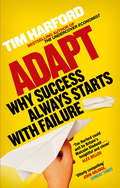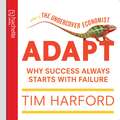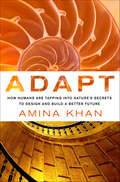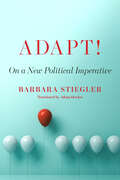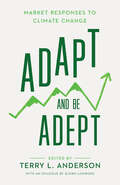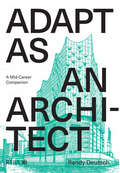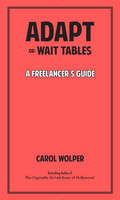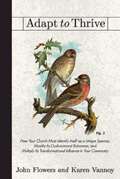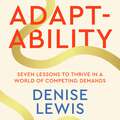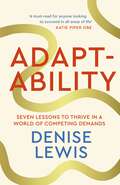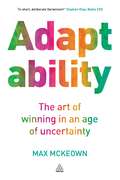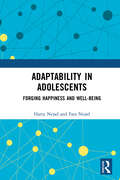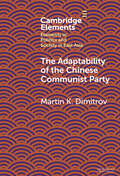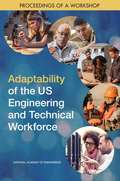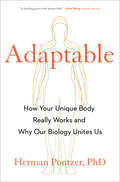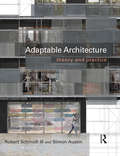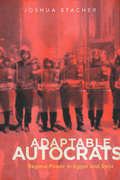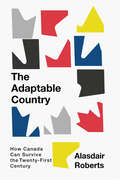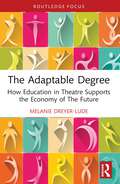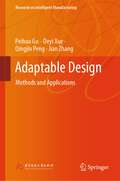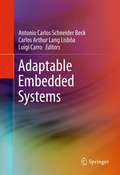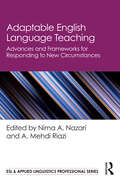- Table View
- List View
Adapt: Why Success Always Starts with Failure
by Tim HarfordEverything we know about solving the world's problems is wrong. Out: Plans, experts and above all, leaders. In: Adapting - improvise rather than plan; fail, learn, and try againIn this groundbreaking new book, Tim Harford shows how the world's most complex and important problems - including terrorism, climate change, poverty, innovation, and the financial crisis - can only be solved from the bottom up by rapid experimenting and adapting.From a spaceport in the Mojave Desert to the street battles of Iraq, from a blazing offshore drilling rig to everyday decisions in our business and personal lives, this is a handbook for surviving - and prospering - in our complex and ever-shifting world.
Adapt: Why Success Always Starts with Failure
by Tim HarfordEverything we know about solving the world's problems is wrong. Out: Plans, experts and above all, leaders. In: Adapting - improvise rather than plan; fail, learn, and try againIn this groundbreaking new book, Tim Harford shows how the world's most complex and important problems - including terrorism, climate change, poverty, innovation, and the financial crisis - can only be solved from the bottom up by rapid experimenting and adapting.From a spaceport in the Mojave Desert to the street battles of Iraq, from a blazing offshore drilling rig to everyday decisions in our business and personal lives, this is a handbook for surviving - and prospering - in our complex and ever-shifting world.
Adapt: How Humans Are Tapping into Nature's Secrets to Design and Build a Better Future
by Amina KhanAmina Khan believes that nature does it best. In Adapt, she presents fascinating examples of how nature effortlessly solves the problems that humans attempt to solve with decades worth of the latest and greatest technologies, time, and money. Humans are animals too, and animals are incredibly good at doing more with less. If a fly’s eye can see without hundreds of fancy lenses, and termite mounds can stay cool in the desert without air conditioning, it stands to reason that nature can teach us a thing or two about sustainable technology and innovation. In Khan’s accessible voice, these complex concepts are made simple. There is so much we humans can learn from nature’s billions of years of productive and efficient evolutionary experience. This field is growing rapidly and everyone from architects to biologists to nano-technicians to engineers are paying attention. Results from the simplest tasks, creating Velcro to mimic the sticking power of a burr, to the more complex like maximizing wind power by arranging farms to imitate schools of fish can make a difference and inspire future technological breakthroughs.Adapt shares the weird and wonderful ways that nature has been working smarter and not harder, and how we can too to make billion dollar cross-industrial advances in the very near future.
Adapt!: On a New Political Imperative
by Barbara StieglerWinner, French Voices AwardThis book, a crossover hit in France, offers a fresh genealogy of our neoliberal moment.“We must adapt!” These words can be heard almost everywhere and in every aspect of our lives. Where does this widespread sense that we have fallen behind come from? How can we explain this progressive colonization of the economic, social, and political fields by this biological vocabulary of evolution? Offering a lucid account of sophisticated material, Barbara Stiegler uncovers the prehistories of today’s ubiquitous rhetoric in Darwinism and American liberalism, while, at the same time, recovering powerful resistances to the rhetoric of adaptation across the twentieth century.Walter Lippmann, an American theorist of this new liberalism, believed democracy was not adapted to the needs of globalization. Only a government of experts could force society to evolve, he argued. Lippmann thus found himself confronted with John Dewey, the great figure of American Pragmatism. Both Lippmann and Dewey labored under the impression that the world had changed and society needed to adapt. However, Lippmann did not trust society to adapt on its own and insisted on the need for experts who would force the necessary adaptation. Dewey, by contrast, believed the necessary adaptation could only come "from below" and should proceed in a democratic fashion. Focusing on readings of Michel Foucault, Walter Lippmann, and John Dewey, Adapt! paves the way for renewed insights into neoliberalism’s history, essence, characteristic forces, and impacts, as well as biopolitical theory. Stiegler presents an intriguing new genealogy for the development of neoliberalism, examining whether humans are by nature lagging and require biopolitical and disciplinary management to enforce adaptation. Stiegler also reorients Foucault’s genealogy of neoliberalism by emphasizing the Darwinian rhetoric of adaptation, as it arose in the Lippmann–Dewey Debate, and deftly handles the question of human nature in a way that re-enlivens this traditional concept. As the industrialization of our ways of life never stops destroying the environment and the health of organisms (climate disruption, the destruction of biodiversity, the growth of chronic diseases, the return of large pandemics), how can we think of a democratic government of life and the living? This is the question that Stiegler’s work helps us to confront.
Adapt and Be Adept: Market Responses to Climate Change
by Terry L. AndersonHow can markets help us adapt to the challenges of climate change? Editor Terry L. Anderson brings together this collection of essays featuring the work of nine leading policy analysts, who argue that market forces are just as important as government regulation in shaping climate policy—and should be at the heart of our response to helping societies adapt to climate change.Anderson notes in his introduction that most current climate policies such as the Paris Agreement require hard-to-enforce collective action and focus on reducing or mitigating greenhouse gases rather than adapting to their negative effects. Adaptive actions can typically deliver much more, faster and more cheaply than any realistic climate policy. The authors tackle a range of issues: the hidden costs of renewable energy sources, the political obstacles surrounding climate change policy, insurance and financial instruments for pricing risk of exposure to the effects of climate change, and more.Reliance on emerging renewable energies and a carbon tax are not enough to prevent the effects of global warming, they argue. We must encourage more private action and market incentives to adapt to a rapidly changing climate.
Adapt As An Architect: A Mid-Career Companion
by Randy DeutschAdapt As An Architect: A Mid-Career Companion is the only book that helps design professionals to navigate the vast heart of the architect’s journey. It serves as a roadmap: a career GPS that provides options for architects getting from where they are today to where they really want to be. The focus of this optimistic, engaging book is on continued relevance, professional engagement, perseverance, and career longevity. It argues that mid-career is the lynchpin of the architect’s career, and provides the guidance and support that practices themselves are missing for emerging professionals, who are often left to their own devices to find their way as they approach the middle of their career. This book means architects don’t need to navigate these years on their own.
Adapt or Wait Tables
by Carol WolperInability to adapt is the new illiteracy and freelancing is becoming America's new normal. What 2008 taught America was not just that derivatives are dangerous and the housing market doesn't rise forever. It also taught us that survival requires juggling and pivoting, two skills that any freelancer is forced to acquire if they want to keep paying their rent. Adapt or Die is a mix of information, tricks and advice for all the freelancers out there, and the ones who will be stepping onto that playing field as they graduate from college. Written by a freelance writer who has spent the past two decades covering Hollywood and the world of pop culture and fashion, their tips for survival are laced with gossip and references to the famous as well as what they call the "secret celebrities" whose paths they have crossed. Consider this an entertaining how-to manual for anyone with ambition and no road map.
Adapt the Master Brand to Silo Markets: Developing a Master Brand Strategy
by David AakerStandardizing the brand and supporting marketing programs across all silos of an organization facilitates consistency in look, feel, and message. In addition, the chances of creating synergistic marketing programs will be enhanced, and the organization will be more likely to rally around the brand promise. However, there are situations in which a standardized brand is not optimal or even feasible because it cannot deliver a winning position in a silo market. In that case, there needs to be a process to adapt a master brand so that it has traction in each silo market while maintaining consistency to its core values.
Adapt to Thrive: How Your Church Must Identify Itself As A Unique Species, Modify Its Dysfunctional Behaviors, And Multiply Its Transformational Influence In Your Community
by John Flowers Karen VannoyThrough stories from real churches and real people, Adapt to Thrive offers an engaging metaphor for the adaptive development of God's creation. This call to action reveals how your church must identify itself as a unique species, modify its dysfunctional behaviors, and multiply its transformational influence in the community.
Adaptability: Seven Lessons to Thrive in a World of Competing Demands
by Denise LewisHarness the power of adaptability to embrace change, overcome obstacles and achieve success.Women are facing more pressure and stress than ever before. Between work, childcare, caregiving responsibilities, maintaining relationships and looking after finances, many are struggling to manage the demands placed on them, with a significant number feeling overwhelmed and unable to cope at times. These challenges are something that Denise Lewis understands well; as an athlete, broadcaster, woman, and mother, her life, like that of many women, is one of constant adaptation. Now, Denise is determined to help women harness the power of adaptability. She aims to teach you how to become your own life coach and navigate the many roles we take on throughout life. In Adaptability, she will guide you through seven key lessons learned from her experiences both on and off the track, including maintaining your identity, building resilience, seeking support, trusting your instincts, and more. By applying these principles, women from all backgrounds can unlock their full potential, develop the tools to overcome challenges, and embrace their multifaceted identities both at work and beyond.While we may not be able to have it all, we can come close by consciously cultivating the skills needed to thrive in every area of our lives.
Adaptability: Seven Lessons to Thrive in a World of Competing Demands
by Denise LewisHarness the power of adaptability to embrace change, overcome obstacles and achieve success.Women are facing more pressure and stress than ever before. Between work, childcare, caregiving responsibilities, maintaining relationships and looking after finances, many are struggling to manage the demands placed on them, with a significant number feeling overwhelmed and unable to cope at times. These challenges are something that Denise Lewis understands well; as an athlete, broadcaster, woman, and mother, her life, like that of many women, is one of constant adaptation. Now, Denise is determined to help women harness the power of adaptability. She aims to teach you how to become your own life coach and navigate the many roles we take on throughout life. In Adaptability, she will guide you through seven key lessons learned from her experiences both on and off the track, including maintaining your identity, building resilience, seeking support, trusting your instincts, and more. By applying these principles, women from all backgrounds can unlock their full potential, develop the tools to overcome challenges, and embrace their multifaceted identities both at work and beyond.While we may not be able to have it all, we can come close by consciously cultivating the skills needed to thrive in every area of our lives.
Adaptability: Seven Lessons to Thrive in a World of Competing Demands
by Denise LewisHarness the power of adaptability to embrace change, overcome obstacles and achieve success.Women are facing more pressure and stress than ever before. Between work, childcare, caregiving responsibilities, maintaining relationships and looking after finances, many are struggling to manage the demands placed on them, with a significant number feeling overwhelmed and unable to cope at times. These challenges are something that Denise Lewis understands well; as an athlete, broadcaster, woman, and mother, her life, like that of many women, is one of constant adaptation. Now, Denise is determined to help women harness the power of adaptability. She aims to teach you how to become your own life coach and navigate the many roles we take on throughout life. In Adaptability, she will guide you through seven key lessons learned from her experiences both on and off the track, including maintaining your identity, building resilience, seeking support, trusting your instincts, and more. By applying these principles, women from all backgrounds can unlock their full potential, develop the tools to overcome challenges, and embrace their multifaceted identities both at work and beyond.While we may not be able to have it all, we can come close by consciously cultivating the skills needed to thrive in every area of our lives.
Adaptability
by Max MckeownAll success is successful adaptation. All failure is a failure to adapt. Adaptability is about the powerful difference between adapting to cope and adapting to win. Fascinating real-world examples from business, government, and sport, military and wider society bring the rules of adaptability to life. From the world's most innovation corporations to street-level creativity emerging from the slums. From McDonalds to Sony, from post-war Iraq to the revolutions of the Arab Spring, from the bustling markets of Hong Kong to the rubber marked circuit of the Monte Carlo Rally. With insightful rules, Max Mckeown shows you how to increase the adaptability of your organization to create winning positions. Human history is a story of competition to adapt between groups and individuals. It has never been more important to understand how to think better and adapt.
Adaptability in Adolescents: Forging Happiness and Well-Being
by Harry Nejad Fara NejadThis book discusses a newly developed concept of adaptability capacity and development as an extension of Charles Darwin’s work on adaptability. It looks at how the human mind uses adaptability resources to deal with life-changing, challenging, and varying circumstances and conditions. The volume presents an integrative process model that assesses the roles of socio-demographic and ability covariates, personality, and other dispositional presage factors in predicting psychological well-being outcomes, such as life satisfaction, happiness, and self-esteem. While exploring the concept of adaptability capacity, the volume focuses on making children and adolescents mentally, emotionally, and behaviorally adaptable. It discusses general and domain-specific constructs relevant to phenomena such as self-regulation, resilience, buoyancy, and coping mechanisms. The book focuses on the development and utilization of treatments to assist individuals in becoming positively adaptable and achieve a higher degree of positive well-being and self-actualization. An important contribution, this book will be of interest to students, researchers and teachers of psychology, educational psychology, and social work. It will also be helpful for academicians, mental health professionals, social workers, psychiatrists, counsellors, and those working in related areas.
The Adaptability of the Chinese Communist Party (Elements in Politics and Society in East Asia)
by Martin K. DimitrovThe Chinese Communist Party (CCP) celebrated its one-hundredth birthday in 2021. Its durability poses a twofold question: How has the party survived thus far? And is its survival formula sustainable in the future? This Element argues that the CCP has displayed a continuous capacity for adaptation, most recently in response to the 1989 Tiananmen protests and the collapse of communism in Europe. As the CCP evaluated the lessons of 1989, it identified four threats to single-party rule: economic stagnation; socioeconomic discontent; ideological subversion; and political pluralism. These threats have led to adaptive responses: allowing more private activity; expansion of the social safety net; promotion of indigenous cultural production; and rival incorporation into the party. Although these responses have enabled the CCP to survive thus far, each is reaching its limit. As adaptation stagnates, the strategy has been to increase repression, which creates doubt about the ongoing viability of single-party rule.
Adaptability of the US Engineering and Technical Workforce: Proceedings Of A Workshop
by National Academies of Sciences Engineering MedicineIn 2015 the National Academy of Engineering (NAE) released the report Making Value for America: Embracing the Future of Manufacturing, Technology, and Work. That study observed that technological developments, reengineered operations, and economic forces are transforming the way products and services are conceived, designed, made, distributed, and supported, a transformation that is having profound effects on the world of work. Jobs consisting of repetitive tasks are being disrupted by automation or offshored to lower-cost producers. Workers are being asked to upgrade their skills to become more productive and adaptable. So far these changes have been most notable in manufacturing and high-technology services, but they are poised to also transform enterprises in energy, health care, education, and other sectors. To explore the effects of these changes on the workforce and on individual workers, the NAE held a workshop November 2–3, 2017, entitled “Preparing the Engineering and Technical Workforce for Adaptability and Resilience to Change.” The first goal of the workshop was to increase stakeholders’ understanding of both the importance of workforce adaptability and the definition and characteristics of adaptability. The second goal was to provide an opportunity to share best practices for fostering adaptability and to identify needs for future study and development. This publication summarizes the presentations and discussions from the workshop.
Adaptable: How Your Unique Body Really Works and Why Our Biology Unites Us
by Herman Pontzer PhDA new understanding of how our bodies work, how to keep them healthy, and how our biological diversity unites us rather than divides usHow does the body work—and why does it seem to work so differently for each of us? Why do we grow tall or short, obese or slim? Why do some of us stay healthy despite our bad habits while others who do all the right things fall ill? When we look around the planet, why do people vary in skin color, facial features, stature, body proportions, and disease risk? The answer is both simple and powerful: We&’re different because we&’re adaptable. Over the past 100,000 years, as humans expanded into every biome on the planet, our bodies were fine-tuned to our local environments. Adaptability is at the heart of being human and the engine of our diversity – our species&’ original superpower. As an evolutionary anthropologist working with human populations around the globe, Herman Pontzer has conducted research that embraces our incredible diversity, documenting the connections among lifestyle, landscape, local adaptations, and health. Adaptable takes us on a tour of the human body. In each chapter, we learn how our bodies navigate an uncertain world: how we grow and mature; how our brains develop and learn; how our hearts, lungs, and digestive systems deliver oxygen and nutrients; how we manage toxins, temperature, and water balance; how we move and reproduce; how our immune system keeps invaders at bay; and how we age and decline. Along the way, we learn how to take care of our remarkable bodies, and that the universe of healthy lifestyles is vast (we don&’t need the latest fad diet or cleanse!). Crucially, we come to see how understanding our bodies helps us make sense of the big issues we face today, from vaccines to heart disease, IQ to athletic excellence, diets and obesity to sex and gender, and what we can do to live longer and healthier.
Adaptable Architecture: Theory and practice
by Robert Schmidt III Simon AustinAdaptable Architecture provides thought-provoking and inquisitive insights into how we can prolong the useful life of buildings by designing them to be more adaptable, and hence create a more sustainable built environment. The book provides a theoretical foundation counterpointed by the experiences and ideas of those involved in the design and use of buildings. It explains many approaches to designing for change, with lessons from history, and case studies including The Cedar Rapids Public Library, Kentish Town Health Centre and Folkestone Performing Arts Centre, which stretch our thinking beyond the conventional notions of adaptability. The authors reveal the many conditions that make it a complex design phenomenon, by considering the purpose, design and business case of buildings as well as the physical product. Full of summaries, diagrams, reference charts, tables, and photos of exemplar solutions for use as conversational tools or working aids, this book is for any professional or student who wants to research, question, imagine, illustrate - and ultimately design for - adaptation. In addition, further information and resources are available through the Adaptable Futures website www.adaptablefutures.com which includes additional case studies, videos, information about industry events and up-to-the-minute developments.
Adaptable Autocrats: Regime Power In Egypt And Syria
by Joshua StacherThe decades-long resilience of Middle Eastern regimes meant that few anticipated the 2011 Arab Spring. But from the seemingly rapid leadership turnovers in Tunisia and Egypt to the protracted stalemates in Yemen and Syria, there remains a common outcome: ongoing control of the ruling regimes. While some analysts and media outlets rush to look for democratic breakthroughs, autocratic continuity-not wide-ranging political change-remains the hallmark of the region's upheaval. Contrasting Egypt and Syria, Joshua Stacher examines how executive power is structured in each country to show how these preexisting power configurations shaped the uprisings and, in turn, the outcomes. Presidential power in Egypt was centralized. Even as Mubarak was forced to relinquish the presidency, military generals from the regime were charged with leading the transition. The course of the Syrian uprising reveals a key difference: the decentralized character of Syrian politics. Only time will tell if Asad will survive in office, but for now, the regime continues to unify around him. While debates about election timetables, new laws, and the constitution have come about in Egypt, bloody street confrontations continue to define Syrian politics-the differences in authoritarian rule could not be more stark. Political structures, elite alliances, state institutions, and governing practices are seldom swept away entirely-even following successful revolutions-so it is vital to examine the various contexts for regime survival. Elections, protests, and political struggles will continue to define the region in the upcoming years. Examining the lead-up to the Egyptian and Syrian uprisings helps us unlock the complexity behind the protests and transitions. Without this understanding, we lack a roadmap to make sense of the Middle East's most important political moment in decades.
The Adaptable Country: How Canada Can Survive the Twenty-First Century (Canadian Essentials #3)
by Alasdair RobertsShifting geopolitics, regional conflicts, climate change, and technology shocks: these are just some of the factors that will make the twenty-first century dangerous for Canada. Adaptability, the capacity to anticipate and manage dangers, is essential for the country to survive and thrive. But Canada is not as adaptable as it once was.In The Adaptable Country Alasdair Roberts explains what this vital ability means and why we are currently falling short. Politicians, he argues, are overloaded and fixated on the next election. Governments no longer launch big projects to think about the future. Leaders have stopped meeting regularly to discuss national priorities. Technological changes have undermined journalism and the ability of citizens to talk civilly about public affairs. The public service has become less agile because of a decades-long buildup of controls and watchdogs. While in many ways Canada is a better country than it was a generation ago, it is also more complex and harder to govern.The Adaptable Country outlines straightforward reforms to improve adaptability and reminds us about the bigger picture: in a turbulent world, authoritarian rule is a tempting path to security. Canada’s challenge is to show how political systems built to respect diversity and human rights can also respond nimbly to existential threats.
The Adaptable Degree: How Education in Theatre Supports the Economy of The Future (ISSN)
by Melanie Dreyer-LudeThis book utilized a mixed-methods research study of the career experiences of theatre graduates in the U.S. to provide data on employment patterns and job satisfaction.With a population of over 1,000 participants, this study examined where graduates were working, how their careers had changed over time, which skills acquired with their theatre degree were being used in current employment, and whether they believed their course of study was worth the financial investment, given their current circumstances. Evidence from this study revealed that a theatre degree provided many of the skills the employment market is currently seeking and that theatre graduates were gainfully employed in multiple sectors of the economy.This important data-based, field-specific information will aid chairs, deans, provosts, politicians, students and parents in deicision-making at a time when arts and humanities departments across the country are under the threat of elimination.
Adaptable Design: Methods and Applications (Research on Intelligent Manufacturing)
by Peihua Gu Deyi Xue Qingjin Peng Jian ZhangThis book provides a comprehensive discussion of Adaptable Design (AD). It covers the conception, method, and application of AD to the real-world product design. AD's benefits are substantial as it upgrades, reuses, remanufactures and recycles products throughout the product lifecycle. It rapidly adapts the existing design in development of new designs. Key elements of AD include rationalized function structures, adaptable product architectures, adaptable interfaces, and adaptability evaluations. The main feature of AD is adaptability in design methods and product applications with general and specific adaptability. AD has also modeling and evaluating adaptabilities.
Adaptable Embedded Systems
by Luigi Carro Carlos Arthur Lang Lisbôa Antonio Carlos BeckAs embedded systems become more complex, designers face a number of challenges at different levels: they need to boost performance, while keeping energy consumption as low as possible, they need to reuse existent software code, and at the same time they need to take advantage of the extra logic available in the chip, represented by multiple processors working together. This book describes several strategies to achieve such different and interrelated goals, by the use of adaptability. Coverage includes reconfigurable systems, dynamic optimization techniques such as binary translation and trace reuse, new memory architectures including homogeneous and heterogeneous multiprocessor systems, communication issues and NOCs, fault tolerance against fabrication defects and soft errors, and finally, how one can combine several of these techniques together to achieve higher levels of performance and adaptability. The discussion also includes how to employ specialized software to improve this new adaptive system, and how this new kind of software must be designed and programmed.
Adaptable English Language Teaching: Advances and Frameworks for Responding to New Circumstances (ISSN)
by A. Mehdi Riazi Nima A. NazariIn an age of rapid technological transformation and evolving teaching settings, the ELT community must adapt to the needs of emerging situations and a diverse range of learners. Adaptable English Language Teaching addresses this need by bringing together contributions from renowned scholars around the world with insights on all major areas of English language teaching with an emphasis on adaptability—of teaching method, context, skills, and priorities.Organized around an innovative past-present-future structure, chapters offer methods, strategies, and perspectives that are adaptable to any difficult or under-resourced context. It delves into engaging through online applications, understanding emerging trends in computer-assisted language learning and teaching, and the implementation of virtual classroom and multimodality in ELT.Given its multifaceted focus, this book will provide ELT practitioners, trainers, trainees, and researchers with invaluable insights and research findings to effectively navigate and adapt to emerging circumstances.
